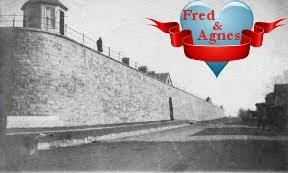 Children’s Christmas wishes and expectations years ago were much different from today’s world of high technology. I was so struck by this—the simplicity and innocence—that I included a chapter entitled Letters to Santa in a recent book on the history of Churubusco, New York. The sample letters below were published in newspapers of northern New York from 1920–1940. They portray the sharp contrast to the modern holiday, where expensive gifts have become the disproportionate norm.
Children’s Christmas wishes and expectations years ago were much different from today’s world of high technology. I was so struck by this—the simplicity and innocence—that I included a chapter entitled Letters to Santa in a recent book on the history of Churubusco, New York. The sample letters below were published in newspapers of northern New York from 1920–1940. They portray the sharp contrast to the modern holiday, where expensive gifts have become the disproportionate norm.
Churubusco was a farming community. Families were self-sufficient, and even small children had daily chores. This fostered teamwork and family unity, and gave children a firsthand understanding of the values of goods, services, and hard work. Those lessons were conveyed in their missives to Santa. And some of the comments in the letters are just plain cute.
1923
Dear Santa,
This year, money being scarce, my wants are few. I want a doll, set of dishes, ribbon, candy, and nuts. Don’t forget my brothers and sisters.
Your girl, Eva Lussier
Dear Santa Claus,
I want you to bring me a little serving set, ball, candy, nuts, and bananas. Never mind the sled this year because I am expecting one from my aunt. My Xmas tree will be in the parlor near the stove, so take your time and get good and warm before you leave.
Wishing you a merry Xmas, your little friend,
Louis Patnode
1925
Dear Santa Claus,
I would like you to bring me a little bedroom set, some candy, nuts, and bananas.
Your little friend,
Louise Recore
Dear Santa Claus,
I would like a flashlight, sled, gold watch, some candy, nuts, oranges, bananas, and peanuts. Please don’t forget my little brothers, Walter and Francis. Walter would like a little drum, mouth organ, candy, nuts, gum, and oranges. Francis would like a little wagon full of toys, and some candy, nuts, and bananas.
Your little friend,
John Brady
1938
Dear Santa,
For Christmas I want a bottle of perfume and a locket, a 59 cent box of paints that I saw in your sale catalog, a pair of skates, a nice dress, and candy and nuts. I am eleven years old, and Santa, I hope you have a very merry Xmas.
Your friend,
Anita Robare
Dear Santa,
I am writing a few lines to tell you what I want for Christmas. I want a toothbrush, and there is a set of 12 different games in your Christmas catalog for 98 cents. Some of the names of the games are bingo, checkers, and jacksticks. Please bring me this set. I hope you don’t forget my little sister and brothers.
Your friend,
Henrietta Matthews
Dear Santa,
Christmas is drawing near and I would like these things: a pair of ski shoes, pair of fur bedroom slippers, a dump truck, and banjo. I will leave some crackers and milk on the breakfast table.
Your friend,
Ann Elderbaum
Dear Santa,
When you come around for Xmas, I would like to have you bring me a pair of skates and a woolen shirt. It’s all I want for Christmas for I thought that you are getting old and those chimneys will be hard to climb. You will have some bread and milk at Christmas Eve.
Yours truly,
Theodore Leclair
Dear Santa Claus,
I wish you would bring me a sled and a ring. I don’t want very much for I know you are getting old and I don’t want you to carry too much. You will find my stocking near the stove, and on the kitchen table you will find some bread and milk. I want you to leave me some candy, especially peanut brittle. I am 12 years old.
Your friend,
Cecelia Louise Miller
Dear Santa,
I wish you would bring me a popgun, tractor, truck, and an airplane. You will find a bowl of bread and milk near the Xmas tree. You will find my stocking near the stove. I am only seven years old.
Your friend,
Clayton Miller
My Dear Santa,
I am eleven years old, and I wish you would bring me a cowboy suit and a sweater. You will find my stocking near the stairway, and on the kitchen table you will find some corn meal mush.
Your little friend,
Herman Leclair
Dear Santa,
Christmas is drawing near and I thought I would drop you a line and let you know what I want for Christmas. I would like a red sweater, western book, and a fur hood. I will leave you some bread, cake, peanuts, and milk. I don’t want very much because you are growing old and your bag will be too heavy. So I will close and hope to have all I want for Christmas.
Sincerely yours,
Rita Theresa Leclair
Dear Santa,
I would like a new pair of shoes for Christmas.
Ruth Demarse
Dear Santa,
I want a tractor and some colors for Christmas.
Henry Lagree
1939
Dear Santa,
I have been a very good girl this year. I thank you for the things that you brought me last year. For Christmas I would like a doll and a Chinese Checker game. I will leave a lunch for you on the table. I will clean our chimney so you can slide down it. I will hang our stockings near the Christmas tree. I would like to stay up and see you but I am afraid that I would not get any presents so I will go to bed. Well we will have to close.
Your friend,
Helen and Patty Smith
Dear Santa Claus,
I have been a good boy this year. I would like a car that pedals. If you couldn’t bring that, I would like something smaller. And don’t forget Carol my baby sister. And I would like some candy, gum, oranges, and nuts.
Your little friend,
Robert K. Smith
Dear Santa,
I have tried to be a good little girl this year. I am nine years old and in the fifth grade. I would like a pair of ice skates between my sister and I. And don’t forget my baby sister, because she wasn’t here last year and I through that maybe you would forget her. But I guess that you wouldn’t do that trick. And don’t forget the candy, nuts, oranges, and gum.
Your friend,
Helen L. Smith
Dear Santa,
I would like for Christmas a pencil box and drawing paper, candy, and nuts.
Your friend,
Beulah Perry
1940
Dear Santa Claus,
I want a train and candy.
Norman Lafave
Dear Santa,
I would like a box of colors, a teddy bear, candy and nuts.
Agnes Lagree
Dear Santa Claus,
I want a pair of shoes, dress, and Christmas candy and nuts.
Ruth Demarse
From Bloated Toe Publishing, Happy Holidays to all.
Photo: 1916 Christmas advertisement.
Lawrence Gooley has authored ten books and dozens of articles on the North Country’s past. He and his partner, Jill McKee, founded Bloated Toe Enterprises in 2004. Expanding their services in 2008, they have produced 19 titles to date, and are now offering web design. For information on book publishing, visit Bloated Toe Publishing.











